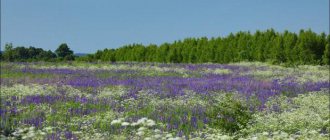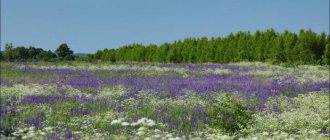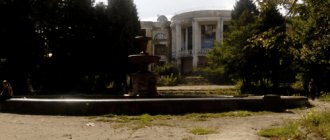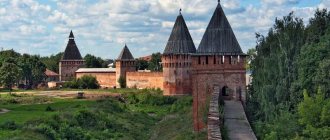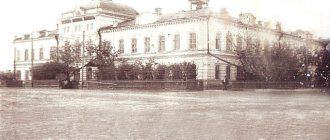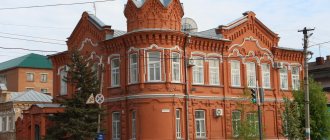Unique Smolensk region
Unique Smolensk region
March 9, 2021 at 4:58 pm
Pochinok. Initiative. Start. Did you know that in modern Russia there are 209 settlements with this name? Eleven of them are located in the Smolensk region. And only one Pochinok in Russia (ours, Smolensk) became a city.
Let's start with dry statistics: in the Pochinkovsky district there are 277 cultural heritage sites, 57 of them are of federal significance, 69 are of regional significance, 151 objects have been identified.
What is so amazing about the Pochinkovo land? She is the ancient beginning of beginnings. It is also the cradle of great families. Arriving here, you will travel back in time more than one and a half thousand years ago. You will see with your own eyes the feat of the saint who stopped the hordes of Tatar-Mongols. Hear about the descendants of the guardian angel who saved the French king in the Third Crusade, and about the family of the great composer. You will learn about those born here: traveler, hero of the War of 1812, Decembrist, admiral, ethnographer, poet...
If you're lucky, you'll taste the unusual water from the treasured well and become a participant in a unique ritual. But first things first.
The beginning began - Tushemlya. Ancient detective
In the 50s of the last century, a special expedition of the Institute of Archeology of the USSR Academy of Sciences was created under the leadership of the world-famous scientist Pyotr Nikolaevich Tretyakov. For six years, research was carried out in the Pochinkovsky region, which revealed completely new groups of ancient population, previously unknown to anyone.
The small river Tushemlya, which flows into the Sozh, gave its name to an entire archaeological culture - Tushemlya, which existed from the 3rd to the 7th centuries. It was here, in the Pochinkovsky district, that archaeologists excavated the first settlement-refuge of the forerunners of the Slavs in the Smolensk region and in the territory of central and northern Belarus.
Who are they? This is where the fun begins! There are still at least three opinions: either they were Slavs, or representatives of the Baltic tribes, or maybe both in the process of assimilation. Scientists, proving their point of view, argued about temple rings, clay shards and iron tools. But we most of all trust the conclusions of the famous Smolensk scientist Evgeniy Alfredovich Schmidt, supported by many of his colleagues: the Balts lived here. And the change of ethnicity in the Upper Dnieper and Podvinia occurred after the turn of the 7th–8th centuries, as a result of the settlement of the Slavs in this territory. Not far from the village of Mokryadino (1.2 km) of the Knyazhinsky rural settlement, a memorial of international significance “Tushemlya”, the only one in Russia, was opened in 2005. The author of the idea and one of the creators of the memorial is Vasily Dmitrievich Savchenkov, journalist, writer, local historian, honorary citizen of Pochinok.
Arriving in Tushemlya, you will see a breathtaking sight - a settlement of the 5th–7th centuries. And who knows, you might suddenly discover a secret - why this shelter once burned down and who the mysterious Tushemlin people really are.
Architecture[ | ]
Development in the center of Pochinka.
The city is characterized by a compact planning structure, which is complicated by a railway line passing through its territory. Residential lands mainly include the central part of the city and certain areas of individual or residential development. Industrial enterprises are scattered throughout the residential area. The location of residential areas in Pochinok has historically developed in the central part of the city[9].
Industrial and municipal warehouse zones are mainly located in the southwestern part of the city and next to the railway. Transport zones are located within the railway right-of-way. The cemeteries are located on two sites within urban areas. Active cemeteries are located in the eastern (Gorodskoye) and western parts of the city in the Boyada area (Boyadinskoye)[9].
Longevity. Saint Mercury and the Tatar-Mongols
In 2002, near the village of Dolgomostye, Losnensky rural settlement, a memorial sign was erected - a chapel in honor of the victory of the squads led by Mercury, who stopped the advance of Batu’s troops towards Smolensk. On one of the huge boulders it is written: “From the grateful people of Smolensk.” Every year at the end of September a spectacular event takes place in Dolgomostye - a holiday in honor of Mercury of Smolensk. Here you can see the feat of the saint - thanks to the reenactors, who are acting out the scene of the battle between the Russian squads and the Horde hordes. And on this day there are buffoon games and a big fair.
Mercury, whom the Orthodox Church has honored since the 16th century as a holy martyr, is revered by the residents of Smolensk as the city's patron. And he accomplished his feat in 1239.
Then the troops of Khan Batu, after an unsuccessful campaign against Veliky Novgorod, turned south. At the beginning of April, the leading hundreds stopped near Dolgomost. The scouts spent a long time looking for the road to Smolensk, and some of them disappeared in the swamp. A local beekeeper, who was captured and could not endure the terrible torture, pointed out the path through the Dolgomostevskoe swamp. And at the edge of the swamp, the Smolensk warriors, led by Mercury, were already standing in battle formation.
According to legend, Mercury obeyed the command of the Mother of God: “Go and defeat the Tatar warriors.” He destroyed many enemies, fought with a giant who inspired fear in everyone, and defeated him. The son of the murdered giant cut off Mercury’s head, but the Tatars left: “Having thrown away their weapons, driven by some unknown force, they fled from the city... and left the borders of Smolensk.”
The beheaded Mercury rose on the battlefield, took his head and came with the news to Smolensk to the city gates. Mercury's body was buried by residents in the Assumption Cathedral.
The cradle of the great composer and the descendants of the “angel”
Three kilometers from Pochinok, on the banks of the Luchesyanka River, is the village of Luchesa. It owes its appearance to a newcomer from distant lands, the Polish nobleman Viktor-Wladislav Glinka. In 1641, for his faithful service to the king, he received a “maetnost” (estate) in the Smolensk region. After the return of these lands to the Moscow state, he accepted Russian citizenship, Orthodoxy and received the name Yakov at baptism. From him came the famous Smolensk family of Glinok. And Luchesa is the cradle of this family.
After Jacob Glinka, Luchesa was inherited from father to son for over a hundred years. In the second half of the 18th century, Evgenia Andreevna, the mother of the great composer Mikhail Ivanovich Glinka, was born here.
And now about the “angels”. One of the most famous noble families in the Smolensk region is the Engelhardts. The legendary founder of the family, Karl Bernard (1159–1230), a knight of the Third Crusade for the liberation of the Holy Sepulcher, received the surname Engelhardt (guardian angel) for saving the life of the French king Philip II Augustus during the siege of Acre. The first of the Engelhardts to enter Russian citizenship was Werner Engelhardt, who converted to Orthodoxy with the name Eremey.
We are most interested in the actual privy councilor, senator, nephew of Grigory Potemkin Vasily Engelhardt, for whom composer Glinka’s uncle, Ivan Andreevich, served as manager of the Smolensk estates since 1819.
Vasily Engelhardt left his manager a substantial share of the three million inheritance. And the heirs fulfilled the father’s will. In a document dated November 5, 1828 it is written: “For his zeal for our parent and for us, his children, we give him four hundred thousand rubles as a reward with the following condition: among this amount, Ivan Andreevich receives the Shmakovo estate, which on the day of his father’s death ... is worth 129,290 rubles for us...”
So the Glinka estate was given to the Shmakovo estate, where the composer’s mother lived with her brother, Afanasy Andreevich, from the age of eight. And Shmakov’s orchestra thundered throughout the entire area. Mikhail Glinka spoke about him like this: “My uncle’s orchestra was a source of the most lively delight for me.”
The Engelhardts did a lot for Glinka. The famous representative of the family, Alexander Platonovich Engelhardt, who was the mayor of Smolensk for more than 20 years, actively participated in raising funds for the creation and opening of a monument to the composer Mikhail Ivanovich Glinka in Smolensk in 1885. In the village of Machuly, Pochinkovsky district, there was another Engelhardt estate. The building of the manor house, although in a very neglected state, can still be seen today. After the death of the male heirs of the Read family, the estate went to Sofya Yakovlevna Read, who married the aforementioned Alexander Platonovich Engelhardt. He began the arrangement: he finally completed the palace and greenhouses, laid out a park with ponds, pavilions and gazebos. Agriculture on the estate was advanced and conducted in an exemplary manner.
Pochinkovsky district of Smolensk region: The original land
Let's start with dry statistics: in the Pochinkovsky district there are 277 cultural heritage sites, 57 of them are of federal significance, 69 are of regional significance, 151 objects have been identified.
What is so amazing about the Pochinkovo land? She is the ancient beginning of beginnings. It is also the cradle of great families. Arriving here, you will travel back in time more than one and a half thousand years ago. You will see with your own eyes the feat of the saint who stopped the hordes of Tatar-Mongols. Hear about the descendants of the guardian angel who saved the French king in the Third Crusade, and about the family of the great composer. You will learn about those born here: traveler, hero of the War of 1812, Decembrist, admiral, ethnographer, poet...
If you're lucky, you'll taste the unusual water from the treasured well and become a participant in a unique ritual. But first things first.
The beginning began - Tushemlya. Ancient detective
In the 50s of the last century, a special expedition of the Institute of Archeology of the USSR Academy of Sciences was created under the leadership of the world-famous scientist Pyotr Nikolaevich Tretyakov. For six years, research was carried out in the Pochinkovsky region, which revealed completely new groups of ancient population, previously unknown to anyone.
The small river Tushemlya, which flows into the Sozh, gave its name to an entire archaeological culture - Tushemlya, which existed from the 3rd to the 7th centuries. It was here, in the Pochinkovsky district, that archaeologists excavated the first settlement-refuge of the forerunners of the Slavs in the Smolensk region and in the territory of central and northern Belarus.
Who are they? This is where the fun begins! There are still at least three opinions: either they were Slavs, or representatives of the Baltic tribes, or maybe both in the process of assimilation.
Scientists, proving their point of view, argued about temple rings, clay shards and iron tools. But we most of all trust the conclusions of the famous Smolensk scientist Evgeniy Alfredovich Schmidt, supported by many of his colleagues: the Balts lived here. And the change of ethnicity in the Upper Dnieper and Podvinia occurred after the turn of the 7th–8th centuries, as a result of the settlement of the Slavs in this territory.
Not far from the village of Mokryadino (1.2 km) of the Knyazhinsky rural settlement, a memorial of international significance “Tushemlya”, the only one in Russia, was opened in 2005. The author of the idea and one of the creators of the memorial is Vasily Dmitrievich Savchenkov, journalist, writer, local historian, honorary citizen of Pochinok.
Arriving in Tushemlya, you will see a breathtaking sight - a settlement of the 5th–7th centuries. And who knows, you might suddenly discover a secret - why this shelter once burned down and who the mysterious Tushemlin people really are.
Longevity. Saint Mercury and the Tatar-Mongols
In 2002, near the village of Dolgomostye, Losnensky rural settlement, a memorial sign was erected - a chapel in honor of the victory of the squads led by Mercury, who stopped the advance of Batu’s troops towards Smolensk. On one of the huge boulders it is written: “From the grateful people of Smolensk.”
Every year at the end of September a spectacular event takes place in Dolgomostye - a holiday in honor of Mercury of Smolensk. Here you can see the feat of the saint - thanks to the reenactors, who are acting out the scene of the battle between Russian squads and the Horde hordes. And on this day, buffoon games are held and a big fair is noisy.
Mercury, whom the Orthodox Church has honored since the 16th century as a holy martyr, is revered by the residents of Smolensk as the city's patron. And he accomplished his feat in 1239.
Then the troops of Khan Batu, after an unsuccessful campaign against Veliky Novgorod, turned south. At the beginning of April, the leading hundreds stopped near Dolgomost. The scouts spent a long time looking for the road to Smolensk, and some of them disappeared in the swamp. A local beekeeper, who was captured and could not endure the terrible torture, pointed out the path through the Dolgomostevskoe swamp. And at the edge of the swamp, the Smolensk warriors, led by Mercury, were already standing in battle formation.
According to legend, Mercury obeyed the command of the Mother of God: “Go and defeat the Tatar warriors.” He destroyed many enemies, fought with a giant who inspired fear in everyone, and defeated him. The son of the murdered giant cut off Mercury’s head, but the Tatars left: “Having thrown away their weapons, driven by some unknown force, they fled from the city... and left the borders of Smolensk.”
The beheaded Mercury rose on the battlefield, took his head and came with the news to Smolensk to the city gates. Mercury's body was buried by residents in the Assumption Cathedral.
The cradle of the great composer and the descendants of the “angel”
Three kilometers from Pochinok, on the banks of the Luchesyanka River, is the village of Luchesa. It owes its appearance to a newcomer from distant lands, the Polish nobleman Viktor-Wladislav Glinka. In 1641, for his faithful service to the king, he received a “maetnost” (estate) in the Smolensk region. After the return of these lands to the Moscow state, he accepted Russian citizenship, Orthodoxy and received the name Yakov at baptism. From him came the famous Smolensk family of Glinok. And Luchesa is the cradle of this family.
After Jacob Glinka, Luchesa was inherited from father to son for over a hundred years. In the second half of the 18th century, Evgenia Andreevna, the mother of the great composer Mikhail Ivanovich Glinka, was born here.
And now about the “angels”. One of the most famous noble families in the Smolensk region is the Engelhardts. The legendary founder of the family, Karl Bernard (1159–1230), a knight of the Third Crusade for the liberation of the Holy Sepulcher, received the surname Engelhardt (guardian angel) for saving the life of the French king Philip II Augustus during the siege of Acre. The first of the Engelhardts to enter Russian citizenship was Werner Engelhardt, who converted to Orthodoxy with the name Eremey.
We are most interested in the actual privy councilor, senator, nephew of Grigory Potemkin Vasily Engelhardt, for whom composer Glinka’s uncle, Ivan Andreevich, served as manager of the Smolensk estates since 1819.
Vasily Engelhardt left his manager a substantial share of the three million inheritance. And the heirs fulfilled the father’s will. In a document dated November 5, 1828 it is written: “For his zeal for our parent and for us, his children, we give him four hundred thousand rubles as a reward with the following condition: among this amount, Ivan Andreevich receives the Shmakovo estate, which on the day of his father’s death ... is worth 129,290 rubles for us...”
So the Glinka estate was given to the Shmakovo estate, where the composer’s mother lived with her brother, Afanasy Andreevich, from the age of eight. And Shmakov’s orchestra thundered throughout the entire area. Mikhail Glinka spoke about him like this: “My uncle’s orchestra was a source of the most lively delight for me.”
The Engelhardts did a lot for Glinka. The famous representative of the family, Alexander Platonovich Engelhardt, who was the mayor of Smolensk for more than 20 years, actively participated in raising funds for the creation and opening of a monument to the composer Mikhail Ivanovich Glinka in Smolensk in 1885.
In the village of Machuly, Pochinkovsky district, there was another Engelhardt estate. The building of the manor house, although in a very neglected state, can still be seen today. After the death of the male heirs of the Read family, the estate went to Sofya Yakovlevna Read, who married the aforementioned Alexander Platonovich Engelhardt. He began the arrangement: he finally completed the palace and greenhouses, laid out a park with ponds, pavilions and gazebos. Agriculture on the estate was advanced and conducted in an exemplary manner.
Antiquities Collector
Nine kilometers southeast of Pochinok is the village of Dankovo. She, too, is directly related to the Glinka family: the composer’s grandmother (maternal) Elena Afanasyevna from the Povalo-Shveikovsky family lived here on her estate.
But the main glory of Dankovo is the name of Vladimir Nikolaevich Dobrovolsky, a member of the Russian Geographical Society, ethnographer writer, linguist, local historian, and collector of oral folk poetry. Dobrovolsky was born in the village of Krasnosvyatsky on August 11, 1856, and died in 1920 from a gangster’s bullet.
Vladimir Dobrovolsky’s parents rebuilt a house in Dankovo. Wonderful scientific works were created here, hundreds of songs, legends, proverbs, sayings and stories were recorded from the words of surrounding residents. Dobrovolsky devoted over 30 years to the study of the folk culture of Central Russia: Smolensk, Oryol, Tula, Kaluga, Tver, Vitebsk, Gomel provinces. Every year on August 11, Dobrovolsky’s birthday is celebrated in the Pochinkovsky district.
Come to Pochinok to get married
In the Pochinkovsky district there is a folklore group of the Stodolishchensky House of Culture - unfortunately, not yet as famous as the Buranovskie Babushki, but no less interesting. One day, young (and not so young) married couples all over Russia will line up so that Pochinkov’s keepers of traditions will arrange for them a wedding ceremony according to the Russian canon: in folk costumes, with braiding, songs of girlfriends, ransom, glorification of the newlyweds... For now, the team is organizing such ritual as a demonstrative concert performance during the holidays.
Soon such a service will become incredibly fashionable, but for now those who wish will have to negotiate with the team directly. But the wedding will be exclusive. By the way, to contact the team, you can contact the culture department of the Pochinkovsky district.
From 1955 to 2010, the folklore group was led by Maria Timofeevna Ivanova, a legend of the Pochinkovo land. She retired only at the age of 85, and having crossed the 90-year mark, she continues to build and implement grandiose plans. This woman is revered and loved by all Pochinkovites. For many years, students from St. Petersburg came to her to record ancient Smolensk songs.
First! Heroes, scientists, discoverers
If there are 277 cultural heritage sites on Pochinkovo land, then you can’t count the amazing people. Many of them are described in the wonderful book “Our Marina” by Vasily Savchenkov, published in 2015.
Hero of the War of 1812, Decembrist Ivan Semenovich Povalo-Shveikovsky was born in the village of Bulovitsy. In a rare case in Russian history, Povalo-Shveikovsky was twice awarded a gold sword with the inscription “For bravery.” He did not participate in the uprising on Senate Square in 1825, but by the decision of the Supreme Criminal Court he was classified as a state criminal of the first category and sentenced to death, commuted to hard labor. In 1839, after completing hard labor, he was transferred to a settlement in the city of Kurgan. He died in 1845 in the arms of the Decembrist V. Kuchelbecker.
In 1837, Vladimir Pavlovich Verkhovsky was born in the village of Tolpeki. Admiral, participant in circumnavigations. His surname is assigned to the islands in the Sea of Japan.
People from Scotland, representatives of the old noble family Leslie, lived in Stankovo. Alexander Dmitrievich Leslie with his father and brothers created in 1812 the first partisan cavalry detachment in Russia, consisting of 200 civilians. The Tsar learned about this from the leader’s report delivered to him by Lieutenant Colonel A.V. Engelhardt (a familiar surname), and soon Alexander I issued a manifesto on the people's militia.
Not far from Murygin, in the village of Kolychevo, the outstanding scientist, predecessor of Charles Darwin, Afanasy Avvakumovich Kaverznev, lived, worked and was buried. In 1775, he published a dissertation “On the Rebirth of Animals” in Germany, where he expressed ideas about evolutionary development.
Kimborovo, five kilometers from Murygin, is the birthplace of the great Russian traveler, the first explorer of Central Asia, Nikolai Mikhailovich Przhevalsky. The list of celebrities goes on...
Revived farm and living water
Once in Pochinka, be sure to stop by the Museum of History and Local Lore at number 14 on Sovetskaya Street. There is a lot of interesting things in the five halls of the museum and storage rooms. And the curator and creator of the museum herself, director Marina Yuryevna Luneva, will tell how in 1986 they began to develop the Zagorye farm, the small homeland of the great Russian poet Alexander Trifonovich Tvardovsky, best known to Russians for his poem “Vasily Terkin”.
Marina Yuryevna remembers how apple trees were planted and buildings were erected. She was friends with the poet’s younger brother, Ivan Trifonovich, and once, as a primary school teacher, she taught Ivan Trifonovich’s granddaughter Marisha, who was much better at mathematics if she counted on candy.
Marina Yurievna, with the light hand of Ivan Trifonovich, became the first director of the Khutor Zagorye museum. It was she who revealed to us an important secret: the water from the well in Zagorye is special, tasty, invigorating. We noticed this when all nine apple trees on the farm, watered from the well, took root. She once carried hundreds of buckets of this water with her own hands...
Memorial Museum-Estate “A.T. Tvardovsky on the Zagorye farm was opened in 1988. Every year on June 21, the poet’s birthday, guests come to Zagorye and a holiday is organized, which you should definitely come to at least once in your life.
Tourist in thought at a crossroads
Are you ready to go on a trip yet? If your journey begins in Moscow, feel free to go to Belorussky Station and buy tickets for the Lastochka train (Moscow - Smolensk). Travel time is 4 hours 10 minutes. And from Smolensk to Pochinok daily (from 7:10 to 21:00) 18 regular buses depart from the bus station. You can arrive in Pochinok by lunchtime. And have lunch. And order a taxi. And check into a hotel. And if you decide to travel from the capital by car, the leisurely trip will take about seven hours (413 kilometers).
By the way, you will like the hotel, located just a kilometer from the center of Pochinka, on Uritsky Street, 51.
It is located on the territory of the Yunost sports and recreation complex. There is everything you need to relax and not spoil your travel experience. New building, modern design, amenities like the best hotels in the country. Guests have access to a sauna, a 25-meter swimming pool with three lanes, a gym and much, much more: from wi-fi and a children's playroom to convenient parking. The prices will pleasantly surprise you, and the fresh air and lack of fuss and noise will be a good addition to the service.
The room can be booked in advance by calling: 8 (48149) 2-31-22; 8 (964)-619-95-41 or via the Internet: otel-pochinok.ru.
When should I arrive? Basically, whenever you want. If you dream of seeing Tushemlya, it’s better in the summer. For example, by June 21, in order to get to the Tvardovsky holiday in Zagorye at the same time. Or August 11, when Dobrovolsky is honored. Or maybe on the 20th of September - see a historical reconstruction and a farmstead fair in Dolgomost.
You don't need to take a long vacation to do this. Residents of the Smolensk region can devote weekends to the Pochinkovsky district, and Muscovites will need three days to get there and back without haste and fuss, see everything and want to come back here again.
Reference
Pochinkovsky district is located in the southwestern part of the Smolensk region. In the north-west it borders with the Smolensky district, in the east - with the Glinkovsky and Elninsky districts, in the south-east and south - with the Roslavl and Shumyachsky districts, in the west - with the Khislavichsky and Monastyrshchinsky.
There are 17 settlements in the region: 1 urban and 16 rural. The administrative center of the district is the city of Pochinok. The first mention of Pochinok dates back to 1811.
The total area of the district is 2,376 km. The total population of the district is 29,851 people. 8,684 people live in Pochinka.
In 1924, Pochinok became the center of the volost and received the name of a town, and two years later it was classified as a city.
The Pochinkovsky district was formed on August 9, 1926 from parts of the Smolensky, Krasninsky, Elninsky and Roslavl districts of the Smolensk province.
Sozh River flows through the western part of the region with a tributary of the Khmara . There are lakes in the region, the largest of which is Lagovskoye .
The Riga – Orel railway and the A141 Orel – Vitebsk highway run parallel to it.
At the entrance to Pochinok from the Roslavl highway, a memorial sign was erected to the crew of Nikolai Gastello (architect S.V. Shestopal). He made his last combat flight from an airfield in the Pochinkovsky district.
The city has an Alley of Heroes, where the memory of the Pochinkovites is immortalized: 3 full holders of the Order of Glory and 15 Heroes of the Soviet Union, among them Vladimir Dmitrievich Lavrinenkov, fighter ace, colonel general of aviation, twice Hero of the Soviet Union.
The Church of the Annunciation of the Blessed Virgin Mary has been operating in the city since 1999.
Antiquities Collector
Nine kilometers southeast of Pochinok is the village of Dankovo. She, too, is directly related to the Glinka family: the composer’s grandmother (maternal) Elena Afanasyevna from the Povalo-Shveikovsky family lived here on her estate.
But the main glory of Dankovo is the name of Vladimir Nikolaevich Dobrovolsky, a member of the Russian Geographical Society, ethnographer writer, linguist, local historian, and collector of oral folk poetry. Dobrovolsky was born in the village of Krasnosvyatsky on August 11, 1856, and died in 1920 from a gangster’s bullet.
Vladimir Dobrovolsky’s parents rebuilt a house in Dankovo. Wonderful scientific works were created here, hundreds of songs, legends, proverbs, sayings and stories were recorded from the words of surrounding residents. Dobrovolsky devoted over 30 years to the study of the folk culture of Central Russia: Smolensk, Oryol, Tula, Kaluga, Tver, Vitebsk, Gomel provinces. Every year on August 11, Dobrovolsky’s birthday is celebrated in the Pochinkovsky district.
Come to Pochinok to get married
In the Pochinkovsky district there is a folklore group of the Stodolishchensky House of Culture - unfortunately, not yet as famous as the Buranovskie Babushki, but no less interesting. One day, young (and not so young) married couples all over Russia will line up so that Pochinkov’s keepers of traditions will arrange for them a wedding ceremony according to the Russian canon: in folk costumes, with braiding, songs of girlfriends, ransom, glorification of the newlyweds... For now, the team is organizing such ritual as a demonstrative concert performance during the holidays.
Soon such a service will become incredibly fashionable, but for now those who wish will have to negotiate with the team directly. But the wedding will be exclusive. By the way, to contact the team, you can contact the culture department of the Pochinkovsky district.
From 1955 to 2010, the folklore group was led by Maria Timofeevna Ivanova, a legend of the Pochinkovo land. She retired only at the age of 85, and having crossed the 90-year mark, she continues to build and implement grandiose plans. This woman is revered and loved by all Pochinkovites. For many years, students from St. Petersburg came to her to record ancient Smolensk songs.
First! Heroes, scientists, discoverers
If there are 277 cultural heritage sites on Pochinkovo land, then you can’t count the amazing people. Many of them are described in the wonderful book “Our Marina” by Vasily Savchenkov, published in 2015.
Hero of the War of 1812, Decembrist Ivan Semenovich Povalo-Shveikovsky was born in the village of Bulovitsy. In a rare case in Russian history, Povalo-Shveikovsky was twice awarded a gold sword with the inscription “For bravery.” He did not participate in the uprising on Senate Square in 1825, but by the decision of the Supreme Criminal Court he was classified as a state criminal of the first category and sentenced to death, commuted to hard labor. In 1839, after completing hard labor, he was transferred to a settlement in the city of Kurgan. He died in 1845 in the arms of the Decembrist V. Kuchelbecker. In 1837, Vladimir Pavlovich Verkhovsky was born in the village of Tolpeki. Admiral, participant in circumnavigations. His surname is given to the islands in the Sea of Japan.
People from Scotland, representatives of the old noble family Leslie, lived in Stankovo. Alexander Dmitrievich Leslie with his father and brothers created in 1812 the first partisan cavalry detachment in Russia, consisting of 200 civilians. The Tsar learned about this from the leader’s report delivered to him by Lieutenant Colonel A.V. Engelhardt (a familiar surname), and soon Alexander I issued a manifesto on the people's militia. Not far from Murygin, in the village of Kolychevo, the outstanding scientist, predecessor of Charles Darwin, Afanasy Avvakumovich Kaverznev, lived, worked and was buried. In 1775, he published a dissertation “On the Rebirth of Animals” in Germany, where he expressed ideas about evolutionary development. Kimborovo, five kilometers from Murygin, is the birthplace of the great Russian traveler, the first explorer of Central Asia, Nikolai Mikhailovich Przhevalsky. The list of celebrities goes on...
Population[ | ]
| Population | ||||||||
| 1931[10] | 1939[11] | 1959[12] | 1970[13] | 1979[14] | 1989[15] | 1992[10] | 1996[10] | 1998[10] |
| 1300 | ↗3182 | ↗7688 | ↗9632 | ↗10 887 | ↘10 753 | ↘10 700 | ↗11 100 | ↘10 800 |
| 2000[10] | 2001[10] | 2002[16] | 2003[10] | 2005[10] | 2006[10] | 2007[10] | 2008[17] | 2009[18] |
| ↘10 600 | ↘10 500 | ↘9578 | ↗9600 | ↘9500 | ↘9300 | ↘9200 | ↘9100 | ↘9012 |
| 2010[10] | 2011[10] | 2012[19] | 2013[20] | 2014[21] | 2015[22] | 2016[23] | 2017[24] | 2018[25] |
| ↘9000 | ↘8800 | ↘8699 | ↘8697 | ↘8675 | ↗8684 | ↘8641 | ↗8688 | ↘8545 |
| 2019[26] | 2020[27] | 2021[1] | ||||||
| ↘8332 | ↘8269 | ↘8171 | ||||||
As of January 1, 2021, in terms of population, the city was in 990th place out of 1116[28]cities of the Russian Federation[29].
Revived farm and living water
Once in Pochinka, be sure to stop by the Museum of History and Local Lore at number 14 on Sovetskaya Street. There is a lot of interesting things in the five halls of the museum and storage rooms. And the curator and creator of the museum herself, director Marina Yuryevna Luneva, will tell how in 1986 they began to develop the Zagorye farm, the small homeland of the great Russian poet Alexander Trifonovich Tvardovsky, best known to Russians for his poem “Vasily Terkin”.
Marina Yuryevna remembers how apple trees were planted and buildings were erected. She was friends with the poet’s younger brother, Ivan Trifonovich, and once, as a primary school teacher, she taught Ivan Trifonovich’s granddaughter Marisha, who was much better at mathematics if she counted on candy.
Marina Yurievna, with the light hand of Ivan Trifonovich, became the first director of the Khutor Zagorye museum. It was she who revealed to us an important secret: the water from the well in Zagorye is special, tasty, invigorating. We noticed this when all nine apple trees on the farm, watered from the well, took root. She once carried hundreds of buckets of this water with her own hands...
Memorial Museum-Estate “A.T. Tvardovsky on the Zagorye farm was opened in 1988. Every year on June 21, the poet’s birthday, guests come to Zagorye and a holiday is organized, which you should definitely come to at least once in your life.
Tourist in thought at a crossroads
Are you ready to go on a trip yet? If your journey begins in Moscow, feel free to go to Belorussky Station and buy tickets for the Lastochka train (Moscow - Smolensk). Travel time is 4 hours 10 minutes. And from Smolensk to Pochinok daily (from 7:10 to 21:00) 18 regular buses depart from the bus station. You can arrive in Pochinok by lunchtime. And have lunch. And order a taxi. And check into a hotel. And if you decide to travel from the capital by car, the leisurely trip will take about seven hours (413 kilometers).
By the way, you will like the hotel, located just a kilometer from the center of Pochinka, on Uritsky Street, 51. It is located on the territory of the Yunost sports and recreation complex. There is everything you need to relax and not spoil your travel experience. New building, modern design, amenities like the best hotels in the country. Guests have access to a sauna, a 25-meter swimming pool with three lanes, a gym and much, much more: from wi-fi and a children's playroom to convenient parking. The prices will pleasantly surprise you, and the fresh air and lack of fuss and noise will be a good addition to the service.
The room can be booked in advance by calling: 8 (48149) 2-31-22; 8 (964)-619-95-41 or via the Internet: otel-pochinok.ru.
When should I arrive? Basically, whenever you want. If you dream of seeing Tushemlya, it’s better in the summer. For example, by June 21, in order to get to the Tvardovsky holiday in Zagorye at the same time. Or August 11, when Dobrovolsky is honored. Or maybe on the 20th of September - see a historical reconstruction and a farmstead fair in Dolgomost.
You don't need to take a long vacation to do this. Residents of the Smolensk region can devote weekends to the Pochinkovsky district, and Muscovites will need three days to get there and back without haste and fuss, see everything and want to come back here again.
Notes[ | ]
- ↑ 123
The permanent population of the Russian Federation by municipalities as of January 1, 2021 (Russian). Date accessed: April 27, 2021. Archived May 2, 2021. - THE USSR. Administrative-territorial division of the union republics on January 1, 1980 / Comp. V. A. Dudarev, N. A. Evseeva. - M.: Izvestia, 1980. - 702 p. — P. 224.
- Pochinok (city in the Smolensk region) // Great Soviet Encyclopedia: [in 30 volumes] / ch. ed. A. M. Prokhorov. — 3rd ed. - M.: Soviet Encyclopedia, 1969-1978.
- Brief information about the development of domestic railways from 1838 to 1990. - M. - P. 11.
- Historical information on the website of the Administration of the Municipal Municipality "Pochinkovsky District" of the Smolensk Region (Russian). pochinok.admin-smolensk.ru
. Date accessed: March 9, 2021. - Cities of Russia: encyclopedia / Ch. ed. G. M. Lappo. - M.: Great Russian Encyclopedia, 1994. - P. 361.
- Resolution of the All-Russian Central Executive Committee dated June 17, 1929 “On the composition of districts and districts of the Western Region and their centers” (Russian). base.consultant.ru
. Access date: March 9, 2021.. - liberation of cities: A guide to the liberation of cities during the Great Patriotic War of 1941-1945. - M.: Military Publishing House, 1985.
- ↑ 1 2
General plan of the Pochinkovsky urban settlement of the Pochinkovsky district.
- 2009. - T. 1. (undefined)
. Date accessed: March 13, 2021. - ↑ 123456789101112
People's encyclopedia "My City". Pochinok (city) - All-Union Population Census of 1939. The size of the urban population of the USSR by urban settlements and intra-city areas (unspecified)
. Retrieved November 30, 2013. Archived November 30, 2013. - All-Union Population Census of 1959. The size of the urban population of the RSFSR, its territorial units, urban settlements and urban areas by gender (Russian). Demoscope Weekly. Access date: September 25, 2013. Archived April 28, 2013.
- All-Union Population Census of 1970 The size of the urban population of the RSFSR, its territorial units, urban settlements and urban areas by gender. (Russian). Demoscope Weekly. Access date: September 25, 2013. Archived April 28, 2013.
- All-Union Population Census of 1979 The size of the urban population of the RSFSR, its territorial units, urban settlements and urban areas by gender. (Russian). Demoscope Weekly. Access date: September 25, 2013. Archived April 28, 2013.
- All-Union population census of 1989. Urban population (undefined)
. Archived from the original on August 22, 2011. - All-Russian population census 2002. Volume. 1, table 4. Population of Russia, federal districts, constituent entities of the Russian Federation, districts, urban settlements, rural settlements - regional centers and rural settlements with a population of 3 thousand or more (unspecified)
. Archived from the original on February 3, 2012. - Cities of the Smolensk region (number of inhabitants - estimate as of January 1, 2008, thousand people) (unspecified)
. Retrieved May 28, 2021. Archived May 28, 2016. - The size of the permanent population of the Russian Federation by cities, urban settlements and regions as of January 1, 2009 (unspecified)
. Retrieved January 2, 2014. Archived January 2, 2014. - Population of the Russian Federation by municipalities. Table 35. Estimated resident population as of January 1, 2012 (unspecified)
. Retrieved May 31, 2014. Archived May 31, 2014. - Population of the Russian Federation by municipalities as of January 1, 2013. - M.: Federal State Statistics Service Rosstat, 2013. - 528 p. (Table 33. Population of urban districts, municipal districts, urban and rural settlements, urban settlements, rural settlements) (undefined)
. Retrieved November 16, 2013. Archived November 16, 2013. - Table 33. Population of the Russian Federation by municipalities as of January 1, 2014 (unspecified)
. Access date: August 2, 2014. Archived August 2, 2014. - Population of the Russian Federation by municipalities as of January 1, 2015 (unspecified)
. Access date: August 6, 2015. Archived August 6, 2015. - Population of the Russian Federation by municipalities as of January 1, 2021 (Russian) (October 5, 2018). Date accessed: May 15, 2021. Archived May 8, 2021.
- Population of the Russian Federation by municipalities as of January 1, 2021 (Russian) (July 31, 2017). Retrieved July 31, 2021. Archived July 31, 2021.
- Estimation of the permanent population of the Smolensk region as of January 1, 2021
- Population of the Russian Federation by municipalities as of January 1, 2021 (Russian). Date accessed: July 31, 2019. Archived May 2, 2021.
- Population of the Russian Federation by municipalities as of January 1, 2021 (Russian). Date accessed: October 17, 2021. Archived October 17, 2021.
- taking into account the cities of Crimea
- https://rosstat.gov.ru/storage/mediabank/bul_Chislen_nasel_MO-01-01-2021.rar Population of the Russian Federation by municipalities as of January 1, 2021 (1.85 Mb, 07/30/2021)
- Tvardovsky A. T.
Selected lyrics. - M.: Young Guard, 1964. - 32 p. — (Library of selected lyrics).


